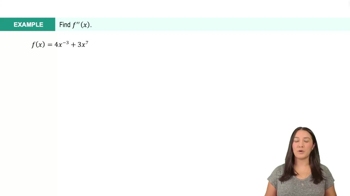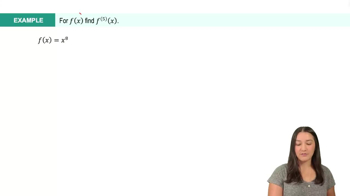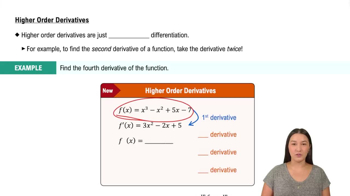Table of contents
- 0. Functions7h 52m
- Introduction to Functions16m
- Piecewise Functions10m
- Properties of Functions9m
- Common Functions1h 8m
- Transformations5m
- Combining Functions27m
- Exponent rules32m
- Exponential Functions28m
- Logarithmic Functions24m
- Properties of Logarithms34m
- Exponential & Logarithmic Equations35m
- Introduction to Trigonometric Functions38m
- Graphs of Trigonometric Functions44m
- Trigonometric Identities47m
- Inverse Trigonometric Functions48m
- 1. Limits and Continuity2h 2m
- 2. Intro to Derivatives1h 33m
- 3. Techniques of Differentiation3h 18m
- 4. Applications of Derivatives2h 38m
- 5. Graphical Applications of Derivatives6h 2m
- 6. Derivatives of Inverse, Exponential, & Logarithmic Functions2h 37m
- 7. Antiderivatives & Indefinite Integrals1h 26m
3. Techniques of Differentiation
Higher Order Derivatives
Problem 71
Textbook Question
Find f′(x), f′′(x), and f′′′(x) for the following functions.
f(x) = (x2 - 7x - 8) / (x + 1)
 Verified step by step guidance
Verified step by step guidance1
Step 1: Identify the function f(x) = \frac{x^2 - 7x - 8}{x + 1}. This is a rational function, so we will use the quotient rule to find the derivatives.
Step 2: Recall the quotient rule for derivatives: if you have a function \frac{u(x)}{v(x)}, then its derivative is given by \frac{d}{dx}\left(\frac{u}{v}\right) = \frac{u'v - uv'}{v^2}. Here, u(x) = x^2 - 7x - 8 and v(x) = x + 1.
Step 3: Compute the first derivative f'(x) using the quotient rule. First, find the derivatives of the numerator and denominator: u'(x) = 2x - 7 and v'(x) = 1. Then apply the quotient rule: f'(x) = \frac{(2x - 7)(x + 1) - (x^2 - 7x - 8)(1)}{(x + 1)^2}.
Step 4: Simplify the expression for f'(x) by expanding and combining like terms in the numerator. This will give you a simplified form of the first derivative.
Step 5: To find the second derivative f''(x), differentiate f'(x) using the quotient rule again. Finally, differentiate f''(x) to find the third derivative f'''(x), ensuring to simplify at each step.
Recommended similar problem, with video answer:
 Verified Solution
Verified SolutionThis video solution was recommended by our tutors as helpful for the problem above
Video duration:
4mPlay a video:
Was this helpful?

 2:42m
2:42mWatch next
Master Higher Order Derivatives with a bite sized video explanation from Callie
Start learningRelated Videos
Related Practice




